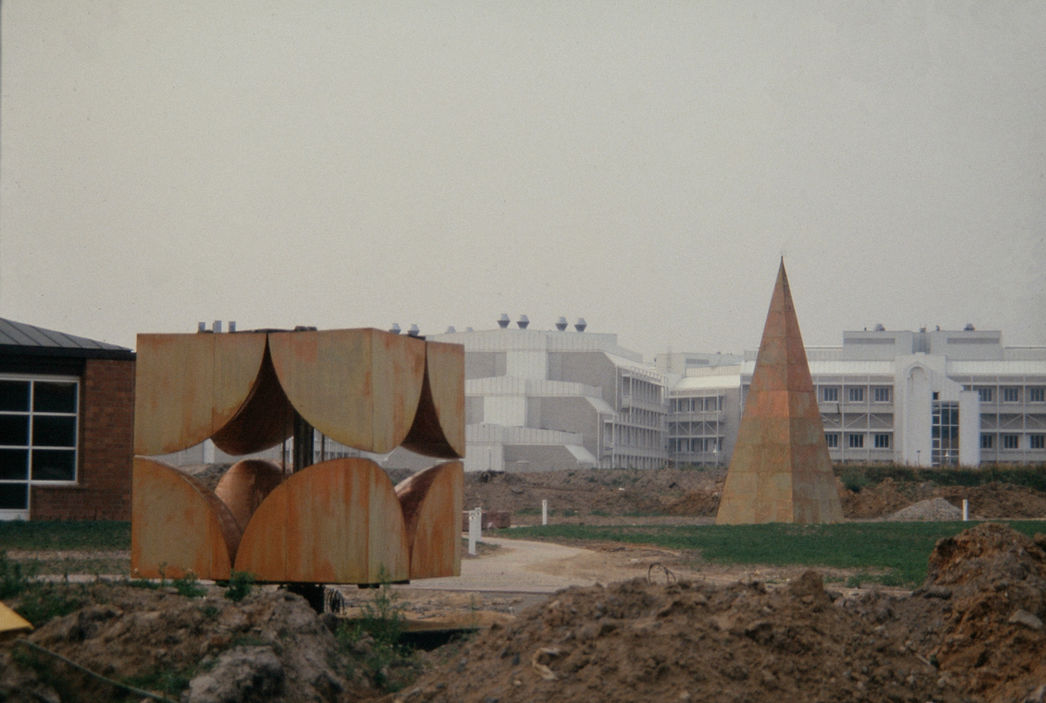A.T E.M. PROJECT LANGEN
A.T E.M. PROJECT
Sculptures for the Flight Safety and Meteorological Services School Langen/Hessen, Germany, completed 1987-1989
The two sculptures consist of four elements: the initial forms, sphere and pyramid, and the mutations, flying objects (air, motion) and cube (earth, statics). Natural and geometric forms interact, change their appearance and create new forms.
The metamorphosis is initiated by means of a time-switch when the sun reaches its highest point. The sphere opens and the cube unfolds. The transformation of the pyramid follows: its upper section inclines downward, and the flying object is released to float above the pyramid's pedestal. The retransformation begins at sundown, as both objects close and re-assume their original shapes
A.T E.M. is a concept that applies to an artistic construction and its manifest expression - in two works of art. The term archaic signifies the three basic forms used: sphere, cube and pyramid. "Technological" refers to the the principle of construction underlying the two objects. And in their movements, each undergoes a metamorphosis. This would all be succint enough; it is the acronym which provokes contradictions and poses questions. (Translation note: Atem is German for breath.) With the life inspired into us as breath, our history began, our perception of what we now, after an infinite number of metamorphoses, can call archaic. And with science and technology, Man's attempt to achieve the second creation began as well. What is also evoked by the concept of the archaic, apart from the basic forms, is the sense of a long-lost unity. We are reminded of an epoch when the artist, the scientist and the priest were united in one and the same person - when the means of gaining insight into highly complex but fundamental relationships lay in the processes of intuition and multi-dimensional comprehension. This world can never be regained. So much is clear. For the metamorphoses of our history have brought progress in science as well as technology, the result of its practical application. Holistic, multi-dimensional thinking fell victim to the primacy of reason, to the discursive model of thought. What was gained was a nearly limitless command of nature; we have indeed made her our subject. What has been lost, however, is the perspective of ourselves. In its absence, Man, himself a part of nature, has subjected himself to his own ideology, the belief in technology. He has become a slave to the second creation, which he, himself, ordained. And he has forgotten his capacity to comprehend in a diversity of ways.Except in art. Art, however, has been seen rather as a playground for phantasy, sensitivity and love, not to be taken seriously. It has been tolerated only by virtue of its lack of influence. Dialogue, which was continually rekindled, and which found its most passionate spokesman in Leonardo da Vinci, died away completely during to the fanfares of the triumphal march of technology during the industrial revolution. At the same time, voices calling for a new interpretation of meaning became louder, because the pillars supporting our purely discursive Cartesian-Newtonian thought structure had begun to sway. And their sway became stronger as it became ever more obvious, despite their inherent ideological stubbornness, that they were indeed built upon myth. Marc van den Broek has always been fascinated by the dialogue between the two fields, which are today rather more sharply divided than ever. Thus he began crossing over the borders until they dissolved before his eyes and he found himself free to travel back and forth between the world of art on the one side and the world of technology on the other. The experience he has gained as a border-crosser is communicated in his language, the formative visual arts.
While creating the two works that comprise the A.T E.M. Project, intuitive, multi-dimensional thinking - that is, holistic comprehension - served both as his foundation and his conceptual scheme throughout. Without hesitation, he availed himself of specialist expertise both in a technology which has itself since become archaic, namely mechanics, and in a modern one - electronics. And from the combination of the two models of thought, separated from one another as they are by wide chasms, emerged the metamorphoses of the sphere into the cube, of the pyramid into the flying object. With these artistic sculptures, Marc van den Broek has presented an offer for dialogue, and through intuitive, multi-dimensional comprehension he has opened up a new approach to solutions as an alternative to the rigid stringency of a technology that finds itself on the verge of discursive disillusionment. Thus solutions now appear which have heretofore posed no problems for art, but against which technology in its tendency towards atomization has been hermetically sealed off and which have always been meaningless to religion. Marc van den Broek's conceptual scheme is an attempt at symbiosis - with a synergetic effect.
© Dr. Detlef Kulessa
Sphere
Diameter: 3 m
Weight: approx. 10 t
Materials: iron inner construction, 8 segments flanged brass planking
8 control motors with shaft encoder
2 main drives (motors for base-plate)
Control: Computer AEG A 500, 2 path control
Underground placement of drives and
control: foundation depth: 5.50
Computer simulation: Fachhochschule Wiesbaden, Faculty of Engineering, 3-D Training. Director: Prof. Dipl.-Ing. W. Wagner
Pyramid
Height: 10 m - Basal surface: 3.50 m x 3,50 m - Weight: approx. 5 t
Materials: iron inner construction brass planking
4 control rods, double-hinged electronic time-switch
Computer simulation: CAD system, "Catia", Dassault Systems, carried out by Dipl.-Ing. Ulrich Reetz









